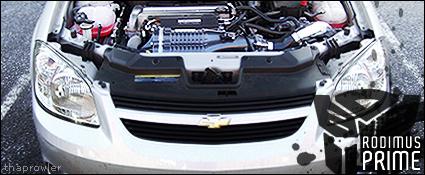



Direct from GM... .
Chevy HHR Panel Delivers Style, Function And Fun In A New, Segment-Exclusive Configuration
The 2007 HHR Panel, designed for a myriad commercial and private uses, adds a new dimension of functionality to the popular HHR’s lineup of stylish, efficient vehicles.
The HHR Panel features windowless side panels and rear cargo doors in place of conventional rear doors. A flat load floor provides more than 57 cubic feet (1,614 L) of cargo space, along with approximately 6 cubic feet (170 L) of additional covered, under-floor storage.
“The HHR Panel is a model unlike anything else in the segment, and it continues HHR’s mission of offering customers a bold, expressive, functional and different vehicle,” said Ed Peper, Chevrolet general manager. “It’s great for delivery companies and other small businesses, but we think auto enthusiasts will love it too, as it gives them a large canvas on which to express their individuality.”
HHR Panel production is expected to start late in the first quarter of 2007. It will be offered in LS and LT trims, with 2.2L and 2.4L engines – both of which help the HHR deliver 30 mpg in highway driving.
“Business customers will see great value in the HHR Panel,” said Peper. “There aren’t many vehicles designed for commercial use that provide 30 mpg.”
Exterior and interior details
HHR’s styling draws upon inspiration from the original 1949 Chevy Suburban, which was built on a platform that also offered panel models – vehicles that became essential tools for urban and small businesses. Over the years, vintage panel vehicles have become prized by collectors and street rodders. The HHR marks the next chapter in Chevy’s panel heritage.
The body of the HHR Panel features steel inserts in place of side windows and cargo doors in place of conventional rear doors. The cargo doors open wide to enable cargo access from both sides of the vehicle, as well as from the rear liftgate. The cargo doors don’t have external handles; they are opened via a dashboard release button. The continuous “canvas” created by the windowless cargo doors and rear panels provides a large area for business logos, advertising or personalization.
An auxiliary power outlet is available in the rear of the cargo area, with available 40-amp service for a variety of specialty equipment needs. This also answers the call of upfitters, who have asked for an additional power source to suit their specialty vehicles.
Inside, the HHR Panel has seating for two and a large, flat cargo floor. Tie-down points are located strategically on the floor and the available, robust floor mats enable easier movement of cargo. Two large storage compartments are located under the cargo floor – in the approximate place of the rear seats of passenger models. When ordered with the optional lockable doors, the compartments are secure and large enough to hold small computer equipment, flashlights, service manuals and other valuable equipment that is more secure when hidden.
Standard and available features
HHR Panel is available in LS and LT trim. Both models come with a fuel-efficient 2.2L engine rated at 149 horsepower (111 kW). The LT model offers a 2.4L engine rated at 175 horsepower (130 kW). With either engine, the HHR is rated at 30 mph in highway driving and can provide up to 450 miles of cruising range on a tank of gas.
Power front seats, a family of radios with MP3 capability, XM Satellite Radio and OnStar are available on both LS and LT models. LT models also offer 17-inch wheels and leather-appointed seating.
Standard safety features include dual-stage frontal air bags with GM’s Passenger Sensing System. This system works with the front passenger seat and differentiates between adults – 5 th percentile females and larger – and small children or child seats to adjust air bag deployment. Head curtain side-impact air bags are available.
SPECIFICATIONS
Overview
Models:
Chevrolet HHR Panel LS and LT
Body style / driveline:
2-passenger, 5-door / front-engine, front-wheel drive
Construction:
welded steel monocoque; galvanized except for roof
EPA vehicle class:
sport utility vehicle – 2WD
Manufacturing location:
Ramos Arizpe, Mexico
Key competitors:
Ford Escape, Jeep Liberty, Scion xB, Honda Element, Chrysler PT Cruiser
Engine
Ecotec 2.2L (L61)
Ecotec 2.4L (LE5)
Application
std on LS and 1LT
std 2LT; opt on 1LT
Type:
2.2L DOHC I-4
2.4L DOHC I-4
Displacement (cu in / cc):
134 / 2189
145 / 2384
Bore & stroke (in / mm):
3.39 x 3.72 / 86 x 94.6
3.46 x 3.85 / 88 x 98
Block material:
cast aluminum
cast aluminum
Cylinder head material:
cast aluminum
cast aluminum
Valvetrain:
overhead camshafts,
4 valves per cylinder
overhead camshafts, 4 valves per cylinder; variable valve timing
Ignition system:
electronic direct
electronic direct
Fuel delivery:
sequential multi-port fuel injection with electronic throttle control
sequential multi-port fuel injection with high-pressure injectors and electronic throttle control
Compression ratio:
10:1
10.5:1
Horsepower (hp / kW @ rpm):
149 / 111 @ 5600
175 / 130 @ 6200
Torque (lb-ft / Nm @ rpm):
152 / 210 @ 4000
165 / 228 @ 5000
Recommended fuel:
regular unleaded
premium recommended but not required
Maximum engine speed:
6500
6750
Emissions controls:
close-coupled catalytic converters; Quick-Sync 24x ignition system; returnless fuel rail; fast-response O 2 sensor
close-coupled catalytic converters; Quick-Sync 24x ignition system; returnless fuel rail; fast-response O 2 sensor
Estimated fuel economy
(mpg city / hwy):
manual: 22 / 30
automatic: 23 / 30
manual: 22 / 30
automatic: 23 / 30
Transmissions
Type:
F23 5-speed manual
Hydra-Matic 4T45 4-speed automatic
Gear ratios: (:1):
First:
3.58
2.95
Second:
2.02
1.62
Third:
1.35
1.00
Fourth:
0.98
0.68
Fifth:
0.69
–
Reverse:
3.31
2.14
Final drive ratio:
4.17:1
3.91:1
Chassis/Suspension
Front:
independent strut-type suspension with stabilizer bar
Rear:
semi-independent torsion beam with stabilizer bar
Steering type:
electric, power-assisted variable-speed rack-and-pinion
Steering ratio:
18.5:1
Steering wheel turns, lock-to-lock: (est)
3.5 (FE1); 3.25 (FE3)
Turning circle, curb-to-curb (ft / m): (est)
36 / 11 (FE1); 37.7 / 11.5 (FE3)
Brakes
Type:
power front disc/rear drum, optional anti-lock brakes
Rotor diameter x thickness (in / mm):
front: 11.65 x 1.02 / 296 x 26
Drum diameter x width (in / mm):
rear: 9.84 x 1.7 / 250 x 45
Wheels/Tires
Wheel size and type:
std: LS and 1LT 16-inch x 6.5-inch steel; opt: 1LT 16-inch x 6.5-inch aluminum
std: 2LT 17-inch x 7-inch painted aluminum ; opt: 2LT 17-inch x 6.5-inch polished aluminum
Tires:
P215/55R16 all-season steel-belted radial blackwall tires; P215/50R17 all-season steel-belted radial blackwall tires
DIMENSIONS
Exterior
Wheelbase (in / mm):
103.6 / 2630
Overall length (in / mm):
176.2 / 4475
Overall width (in / mm):
69.1 / 1755
Overall height (in / mm):
62.5 / 1587
Track (in / mm):
front: 58.7 / 1491
rear: 58.7 / 1491
Minimum ground clearance (in / mm):
6.3 / 159.4
Curb weight, base (lb / kg):
3155 / 1431 (2.2L); 3208 / 1455 (2.4L)
Weight distribution (front / rear):
57 / 43
Interior
Seating capacity:
5
Headroom (in / mm):
front: 39.6 / 1006
rear: 39 / 991
Legroom (in / mm):
front: 40.6 / 1031
rear: 39.5 / 1004
Shoulder room (in / mm):
front: 53.5 / 1358
rear: 52.7 / 1339
Hip room (in / mm):
front: 50.1 / 1273
rear: 50.6 / 1266
Capacities
Passenger volume (cu ft / L)
97.4 / 2758
Cargo volume (cu ft / L):
63.1 / 1787 (rear seats removed)
57.7 / 1634 (rear seats folded)
25.2 / 638 (rear seats up)
GVWR, standard (lb / kg):
4173 / 1893 (preliminary)
Payload, base (lb / kg):
900 / 408
Trailer towing maximum (lb / kg):
1000 / 453
Fuel tank (gal / L):
16.2 / 49
Engine oil (qt / L):
2.2L and 2.4L: 5 / 4.7
Cooling system (qt / L):
48.6 / 46 (2.2L); 51.8 / 49 (2.4L)
Note: Information shown is current at time of publication.
For Release: 10-06-2006
>>>For Sale? Clicky!<<<
-----The orginal Mr.Goodwrench on the JBO since 11/99-----
























